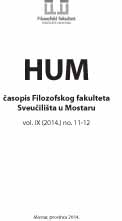
We kindly inform you that, as long as the subject affiliation of our 300.000+ articles is in progress, you might get unsufficient or no results on your third level or second level search. In this case, please broaden your search criteria.









“Boys and girls grow up in different worlds, but we think we’re in the same one, so we judge each other’s behavior by the standards of our own.“ (Tannen, 1990) According to Tannen, the key difference between these two communities, i.e. male and female, is power on the male side and solidarity on the female side. The paper aims at relating Tannen’s theory to the communication strategies of pre-school children (three to six years old) from several Mostar kindergartens. The research carried out for this purpose tries to explain language behavior of girls and boys during children’s interaction in the same-sex groups as well as in the mixed-sex groups and to elaborate on the nature of two different gender cultures, their origins, and examples on how gender-related cultural norms affect language. Children of this age have just begun integration into their own subculture within a culture – men’s or women’s. They are, as far as their gender is concerned, still a, so called, tabula rasa which is yet to be filled with the rules of each subculture.
More...
BPW International is the biggest association of businesswomen and women entrepreneurs in the world. It was founded in 1930 and has members in 110 countries. Its Croatian representative has around forty women members, tradeswomen, entrepreneurs and businesswomen, and its primary goal is business informing, lobbying and education, next to the opening of new supsidiaries all over Croatia. Out of many activities of this non-partisan, non-governmental and non-for-profit organization it is necessary to emphasize its monthly expert lectures in the field of business law and its monthly presentations or promotions of products and services of BPW members. For more information check www.bpw.hr
More...
Recent research has demonstrated that there has been little improvement in quality of media coverage of women in Lithuania. Women’s images are usually sexualized, stereotyped or simply negative. In the media portrayals, women are often confined to the private sphere of home. The article focuses on media representations of women in the context of women-and-media policies in EU and Lithuania. Analyzing the EU, UN and Lithuanian communication policy documents and describing briefly the key media and gender issues in EU and Lithuania, it demonstrates the lack of gender-equal media policy and the sluggishness with which the existing media policy with regard to gender issues is enforced in Lithuania. Addressing the pluralism of women’s roles and images in the media, and fair and sufficient media coverage of women, the article also discusses feminist and post-feminist media studies that could offer more complex and sophisticated media research strategies. The article also proposes some recommendations that could change, to some degree, the existing media and gender situation for the better. The author suggests that policy recommendations need a strong network of public, official and private institutions in order to be implemented successfully. Placing considerable importance on eliminating stereotypes of women and on promoting diverse and nonstereotyped images of women in the media, the article uses the term “conflicted hegemony”. “Conflicted hegemony” implies that the media provide a site for conflicts and debates over different interpretations of the dominant culture, and that ideological counter-tendencies always appear in the dominant ideological forms. Policy recommendations, media research techniques and alternative media interpretations by their consumers can serve as resistance strategies to this hegemony.
More...
In diesem Beitrag wird das Problem näher untersucht, wie der Fortschritt von Einsetzung der Strategien zur Geschlechtergleichheit im Berufsbildungssystem der europäischen Länder zu evaluieren sei, damit das im breiten Sinne angemessene technologische System herausgearbeitet wäre, das zugleich den spezifischen und den allgemeineuropäischen Besonderheiten entspreche. Diese Forschung setzt sich zum Ziel, die Wirksamkeit von Strategien zur Geschlechtergleichheit in Systemen der Berufs- und Hochschulbildung (nicht-universitärer Ausbildung) von verschiedenen Typen in sieben europäischen Ländern (sechs davon sind die EU-Mitgliedstaaten und ein Beitrittsland) zu evaluieren, wobei das breite virtuelle Netz geschaffen wird und die Informations- und Kommunikationstechnologien (IKT) zur Hilfe gezogen werden. Als wichtigstes Kriterium beim Erreichen dieses Zieles erweist sich die Sicherung der gleichberechtigten und demokratischen Identität Europas.
More...
Gender mainstreaming aims to enable the state to deliver gender-sensitive policy instruments and transform gender relations. It is a widely adapted approach that was developed in transnational networks of women activists, but goes beyond women’s policy machinery. Mainstreaming suggests that equal opportunities for women and men should no longer be achieved solely through traditional equal opportunities policies. The article analyses the historical development of gender mainstreaming approach, the promises and pitfalls of the transformative policy. The second part of the study analyses main ideological, institutional, political and legal obstacles to the implementation of gender mainstreaming in different national contexts, including Lithuania.
More...
The main goal of the article is to analyze public attitudes towards gender equality and issues of normative and empirical equality in Lithuania. Following theoretical assumptions, it is aimed at examining of what kind of attitudes people have impact towards gender equality, how sociodemographic characteristics, particularly gender, differentiate them and what kind of factors may explain these differencies. The analysis is based on the empirical data collected in the framework of the sociological research EU Enlargement and Its Commitment to Women carried out by the Department of Sociology, Vytautas Magnus University in 2004. The authors discuss different aspects of gender equality in public opinion, as well as recommendations regarding the improvement of gender policy that are interesting and valuable from the practical, as well as theoretical points of view. What kind of theoretical models and measurements can help to avoid the most frequently made mistakes when analyzing public opinion on the issues of gender equality and policy recommendations? How important is the research on the assessment of gender equality from the methodological point of view? The authors aim at answering the questions by examining the factors that foster or weaken traditional and liberal attitudes towards gender relations on individual and structural levels and shape gender policy recommendations.
More...
The article examines hegemonic and subordinated forms of masculinity in contemporary Lithuania. Using the opinion survey „The Crisis of Male Roles in Lithuania” (2002) and a wide array of literature theorizing men and masculinities, it attempts to answer the following questions: how can we assess the influence of different masculinities to men themselves and gender policies in Lithuania? What kind of masculinity policy can support a feminist project of social transformation? The survey „The Crisis of Male Roles in Lithuania” allows us to conclude that both Lithuanian men and women largely support traditional norms of hegemonic masculinity. This masculinity is based on heterosexuality, economic autonomy, being able to provide for one’s family, being rational, being successful, keeping one’s emotions in check and not doing anything considered feminine. ... The author argues that the dominance of a single model of masculinity at the expense of multiple masculinities makes men more vulnerable to acts of violence against themselves and their families. The article advocates self-awareness and critical reflection about gender identities among men and male groups that could help dismantle hegemonic masculinity and dispel the notion that there is only one way to be a ‘real man’. Promoting models of masculinity along less sexist, homophobic and misogynist lines could benefit both women and men.
More...
The article continues the Lithuanian academic discourse and centers on the analysis of imagery that make up a concurrent part of modern mass culture and form codes of symbolic gender representation. Women’s representation strategies that make possible or, on the contrary, impossible the representation of women as subjects in the mass media are approached from the point of view of psychoanalysis, gender theory, mass media and cultural studies. The author focuses on the codes of “everyday pornography”, i.e., the naturalization of gender hierarchy, objectification of woman’s image, erotization of violence, and silencing of women, that are deeply rooted in the Lithuanian mass culture. She also analyses visual strategies that reinforce masculine hegemony and links their deconstruction with the critical evaluation of heterosexual imperative that supports the normative gender system.
More...
The Baltic States have made a considerable progress in meeting gender equality directives of European Union (EU) in line with the proclaimed fundamental democratic values of Member States and of Union enlargement policy. Despite progress, equality in day-today life is still undermined by structural gender inequalities and unequal access to rights enjoyed by women and men in practice. The issues of women’s unemployment, poverty, age, and ethnic background clearly manifest the political preferences by national governances of the Baltic States for the expert-bureaucratic model, based on ‘integrationist’ approach to gender equality policies and gender mainstreaming, adapted to the national neo-liberal modifications of the former Soviet gender contract.
More...
This article aims to review and to interpret the gender equity in the political, economical and social areas in the EU. The work is based on Human development perspective and methodology. The article consists of two parts. First part gives an explanation about human development and its measurements methodology such as human development index (HDI), gender-related development index (GDI), gender empowerment measure (GEM). The second part of article argues main thesis: high socioeconomic development automatically does not guarantee equity and equality for both woman and man. According to the data of global Human Development report the greater the gender disparity in basic human development, the lower is a country’s GDI relative to its HDI. Sweden, Latvia, Denmark, Finland have the closest correspondence between HDI and GDI. Ireland, Luxembourg, Austria, Belgium, Greece shows highest gender inequality rates. GEM shows that gender equity gaps in political, economic participation and decisionmaking and power over economic resources exist in all EU states members. HDI, GDI, GEM shows that Lithuania does not reach the average of EU. Article concludes that gender inequality problems exist in each EU country and does not depend directly from economical achievement. The good experience of Scandinavian countries gender policy indicates that for gender equity it is necessary to mainstream gender policy.
More...
Western Europe at the moment, fifteen years after bipolar World order, goes through the crisis of trust. To often was western public attributed to itself break of realsocialistic world, and while doing it, did not want to see that growth of western societies after the year 1945. can only be distortedly observed as a continuous and willingly wanted story of success
More...
Author analyses development of “woman issues“ in Serbia and Yugoslavia during second half of 20th Century, in the context of its influence on marriage and family. Though these influences were often quite indirect, they can be observed as one of the most radical ideological penetration in the process of transformation of traditional value system. Ideological climate of the time implied abolishing of all kinds of authorities which were inbuilt in the bases of traditional social organization. This was primarily related to dissolution of faith in eschatological meaning of historical realities, thus “liberation” from God`s authority appeared to be condition and cause of all other ”liberties“. Atheisation meant gradual reduction of human existence to its ”horizontal“ dimension, and thus represented the base of most radical transformations of contemporary civilization. On the other hand, process of woman liberation, which was partly consequence of first, represented gradual (and still unfinished) realization of vision about different organization of human society inside this horizontal line
More...